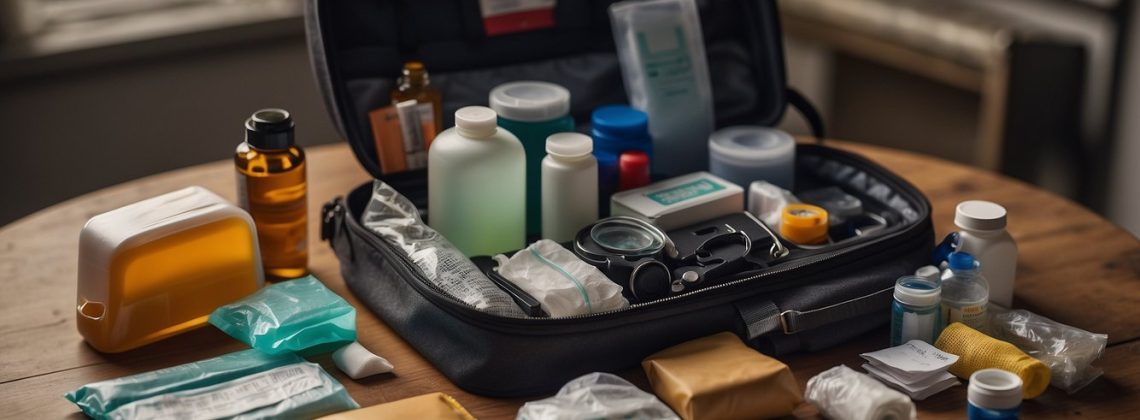
When considering preparedness for emergencies, one essential component to take into account is crafting a well-equipped first aid kit for your bug out bag. A bug out bag is a personal evacuation kit designed to sustain you for at least 72 hours in a crisis. It’s a proactive measure to ensure that, in the event of an emergency, you possess the necessary items to maintain safety and health while on the move.
Your first aid kit within the bug out bag should be comprehensive yet compact, balancing the need for thoroughness with the practicality of portability. This kit will be crucial in managing injuries and health issues that may arise when professional medical help is not immediately accessible. Items should be thoughtfully selected, considering the most common medical scenarios one may encounter during an emergency.
Having a first aid kit list serves as a guideline to ensure nothing vital is overlooked. It is the foundation of your overall strategy for emergency preparedness, empowering you to act effectively when confronted with adverse situations. Remember that the contents may vary depending on personal needs, the environment, and the nature of potential threats, but there are core items that should be included as a standard in every kit.
Foundations of a Bug Out Bag First Aid Kit
A robust first aid kit is crucial for your bug out bag (BOB), as it provides you with the tools necessary to manage injuries during emergencies. The success and utility of your kit will rely heavily on the choice of backpack, the included essential components, and personal protection items.
Choosing the Right Backpack
Your bug out bag should be lightweight yet durable, capable of withstanding harsh conditions. Consider the size of the backpack based on your ability to carry it comfortably—it should align with your age and body weight to prevent strain. Look for compartmentalization options, as organization can be critical in emergency situations where you need to access first aid supplies quickly.
Essential First Aid Components
Your kit must include items that address a wide range of injuries:
- Bleeding control: Trauma pads with blood clotting agents and roller bandages.
- Wound care: Sterile gauze, butterfly closure strips, and options for closing larger wounds like suture kits or wound staplers.
- General care:
- Bandages of various sizes
- Antiseptic wipes and creams
- Pain relievers and anti-inflammatory medication
- Tweezers and scissors for precision tasks
Personal Protection Items
To safeguard against infection, include personal protection items:
- Medical gloves: At least 2-3 pairs to prevent contamination.
- Face masks: To protect against airborne pathogens.
- Safety goggles: If you’re dealing with hazardous materials.
Remember, the kit should never be too heavy to compromise your mobility. Regularly review and adjust the contents based on your personal needs and the evolving conditions.
Medical Supplies
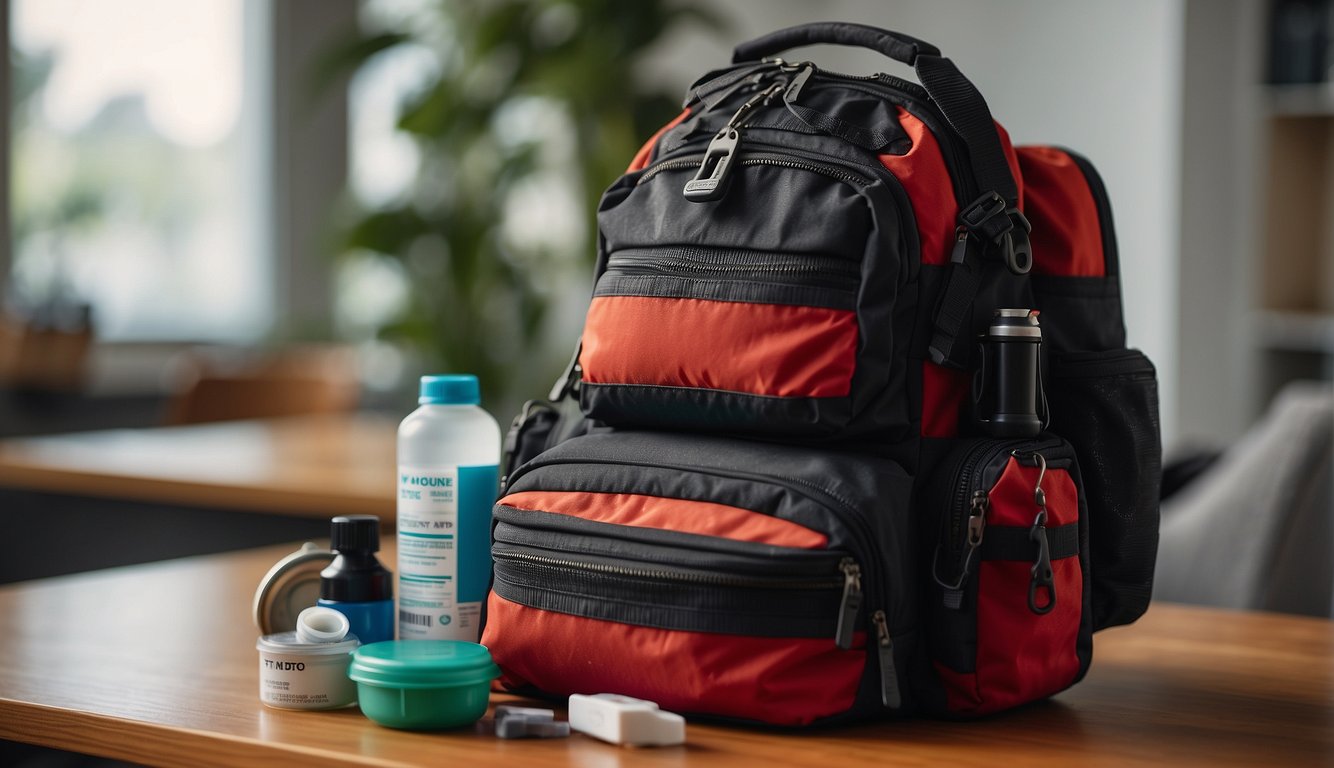
A bug out bag should be equipped with medical supplies that cater to a diverse range of medical issues, from basic cuts to more severe traumas. It’s essential for these supplies to be organized, reliable, and accessible during emergencies.
Trauma Care Items
Trauma Pads with Blood Clotting Agent:
- 3-5 trauma pads that help control bleeding.
Gloves:
- At least 2-3 pairs of medical gloves to maintain sterility and protect against contamination.
Gauze:
- 5 8″x10″ sterile heavy gauze pads for dressing wounds.
Medical Tape:
- Sufficient medical tape for securing gauze and bandages.
Suture Kit/Wound Stapler:
- A suture kit or wound stapler for closing larger wounds.
General First Aid Supplies
- Essential for preventing infections in cuts and injuries.
Antiseptic:
- To clean wounds and prevent the risk of infection.
Bandages:
- A variety of bandages, including 4-inch butterfly closure strips and ace bandages.
Splint:
- For immobilizing broken or sprained limbs.
Hygiene and Sanitation
Hand Sanitizer:
- To keep hands clean and prevent the spread of germs.
General Hygiene Items:
- Such as soap, which can be vital for cleaning and maintaining wounds.
Specialized Medical Equipment
IFAK/Individual First Aid Kit:
- A compact version for personal use that contains vital medical supplies such as tweezers and bandages.
Trauma Kit:
- A comprehensive kit that includes supplies for more serious injuries, potentially including advanced items like a tourniquet or a chest seal.
It’s imperative that you ensure the quality of all the items in your first aid supply and routinely check them to replace any expired or used items.
Survival Essentials
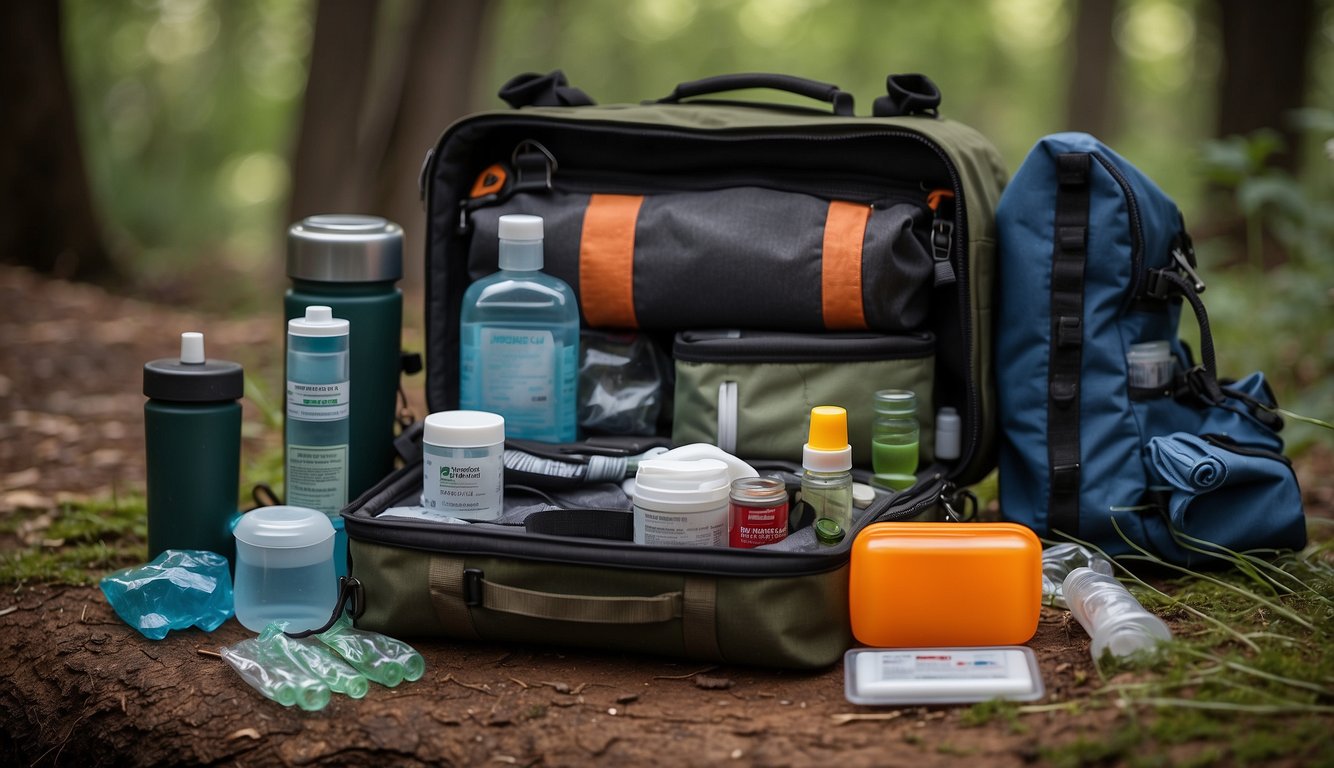
In assembling your bug out bag’s first aid kit, prioritize items critical for survival. These essentials safeguard against the elements, ensure hydration and nutrition, and provide shelter—major determinants of your well-being in emergency situations.
Shelter and Warmth
Your survival hinges on maintaining body temperature, so a lightweight tent is indispensable for protection from the elements. Pair this with an emergency blanket, often made of thermal reflective material, to retain body heat. Also, include a reliable means to start a fire, such as waterproof matches or a firestarter, to stay warm and signal for help if necessary.
- Shelter options:
- Lightweight tent
- Emergency blanket
- Warmth items:
- Firestarter
- Waterproof matches
Hydration and Water Purification
Staying hydrated is vital. Always have a durable water bottle and back up with a water filter or purification tablets to ensure access to clean water. Remember, you should aim to pack at least one gallon of water per person per day, either pre-bottled or accessible through purification.
- Hydration tools:
- Water bottle
- Hydration bladder
- Purification methods:
- Water filter
- Purification tablets
Nutrition and Energy
You need calories for energy to survive. Include high-energy, non-perishable food items such as energy bars or dehydrated meals in your survival kit. These supplies should be lightweight and have a long shelf life for maximum efficacy and minimal burden.
- Food essentials:
- Energy bars
- Dehydrated meals
Navigation and Communication
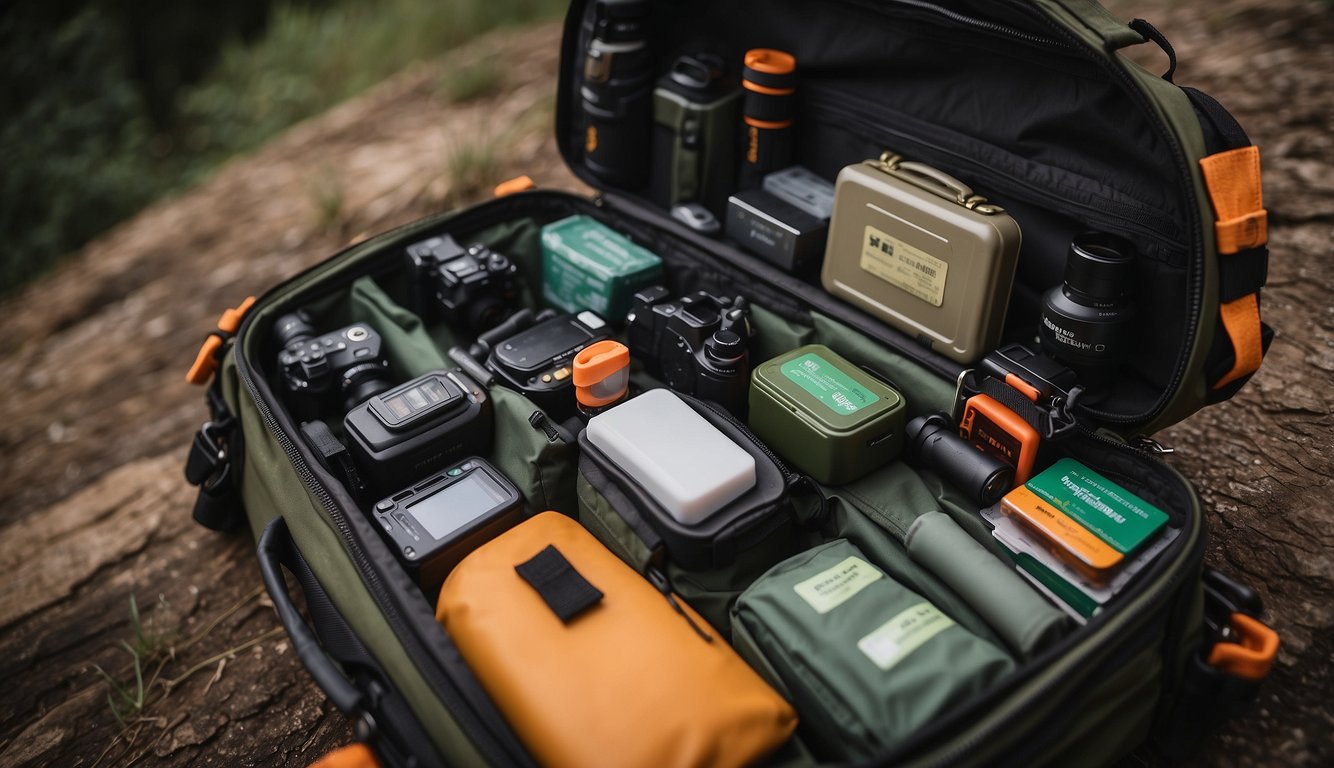
In a crisis, your ability to navigate through unfamiliar territory and communicate with others can be critical to your survival. Ensure your bug out bag includes tools for orientation and devices that will help you stay connected or signal for help.
Orientation Tools
Your primary tool for navigation is a compass; it’s reliable and doesn’t require power. Complement it with detailed maps of your local area and potential destinations. Understanding how to use these tools together is vital for pinpointing your location and planning routes.
- Compass: Essential for directional navigation.
- Maps: Roads, topography, and important landmarks.
Signaling and Connectivity
For communicating your location or signaling distress, a signal mirror and whistle are lightweight and simple to use. A cell phone, preferably with pre-downloaded maps, aids in both navigation and communication, although it relies on battery life. A multi-tool or multitool can be beneficial for repairing gear, which indirectly supports your navigation and communication needs.
- Signal Mirror: Used to reflect sunlight and signal aircraft or rescuers.
- Whistle: To signal for help without exhausting your voice.
- Cell Phone: For calls and GPS, but ensure you have battery backup.
- Multi-tool: Can repair gear that is essential for navigation and communication.
Additional Tools and Accessories
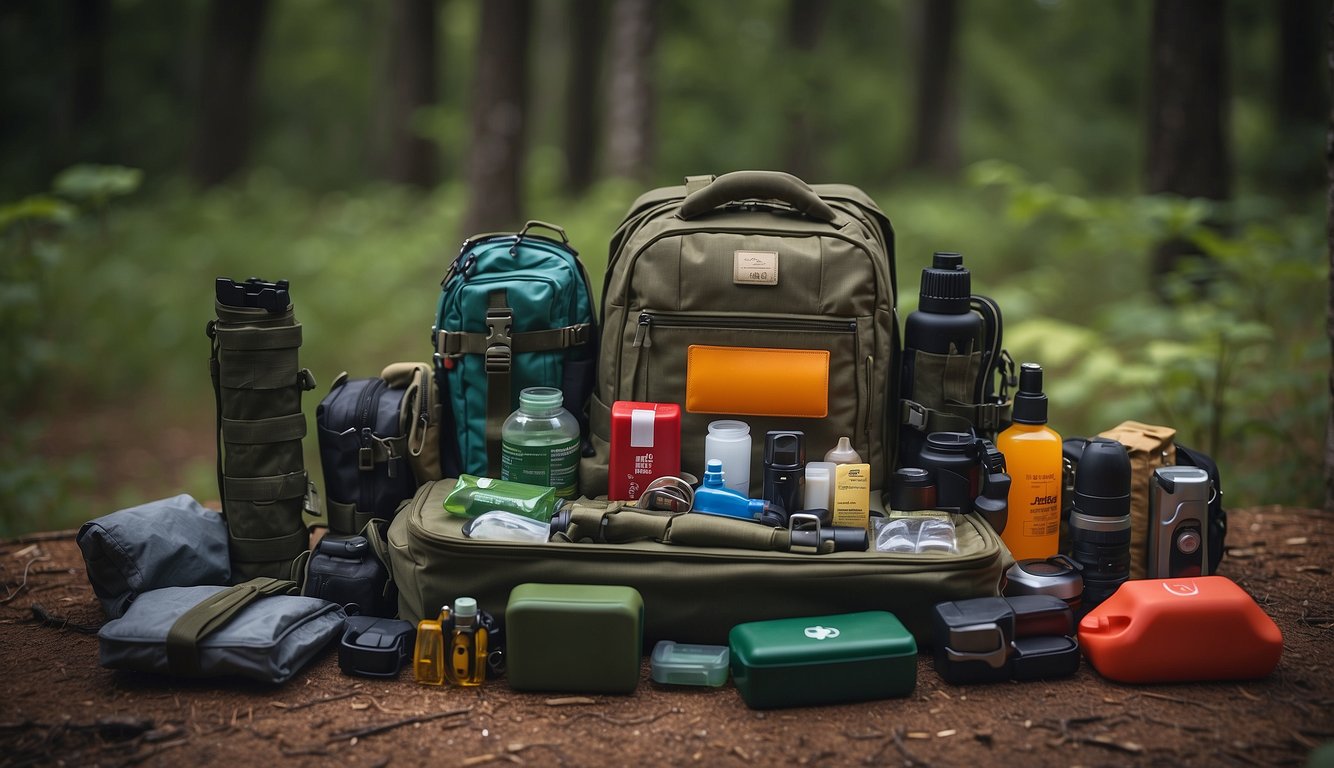
When ensuring your bug out bag is well-equipped, beyond the basics of first aid, it’s crucial to consider tools and accessories that can assist in repair, maintenance, and unforeseen needs in a variety of survival scenarios.
Repair and Maintenance
Your bug out bag should include a multi-tool, which is invaluable for on-the-spot repairs. Ensure yours is equipped with pliers, a knife, screwdrivers, and a can opener to cover basic needs. Duct tape is another essential item due to its versatility; it can patch up gear, mend tears in clothing, and even provide temporary wound care in a pinch.
For cutting tasks, invest in a reliable survival knife that can handle heavy-duty work. A sewing kit with needles and thread can maintain the integrity of your gear. Additionally, paracord is a must-have; it’s not only useful for tying down equipment but can be used for emergency repairs.
Miscellaneous Gear
In terms of starting a fire, pack a lighter and waterproof matches. For backup, consider a magnifying glass not just for detailed work but also as a solar fire-starter. Tinder such as cotton balls soaked in Vaseline can aid in quickly starting a fire in an emergency.
For hygiene, don’t forget soap or hand sanitizer to prevent infections. A bandana is surprisingly useful: it can serve as a filter, a cooling neck wrap, or protect from the sun. Flashlights and a headlamp should also be packed not only for visibility at night but can be critical in signaling for help. Make sure you pack extra batteries for them as well.
Remember, these tools and accessories can mean the difference between a manageable situation and a dire one when SHTF (when “Stuff Hits The Fan”). They’re as important as medical supplies in your first aid kit because, in the wilderness, you’re the first responder to every scenario—be it a scrape or a more serious survival situation.
Apparel for Protection and Mobility
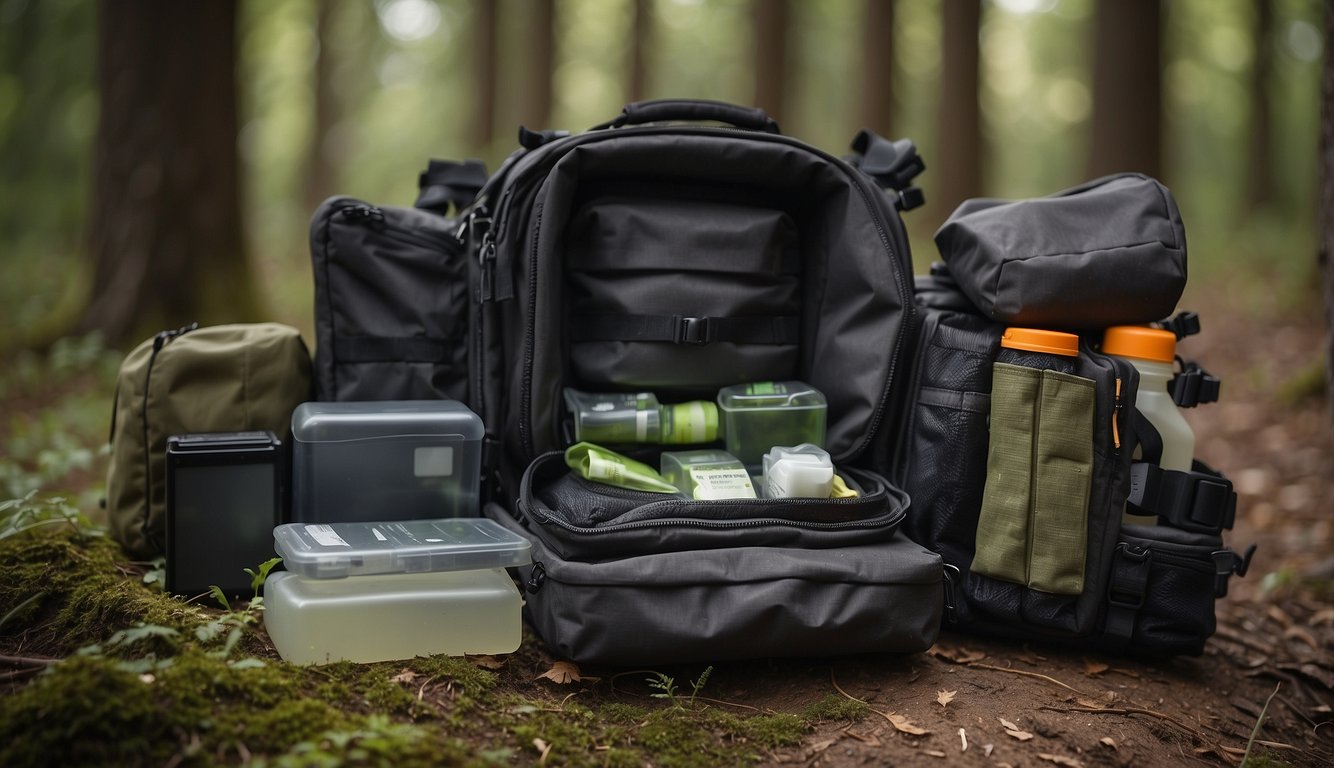
When preparing your bug out bag, your apparel choices are crucial for ensuring protection and maintaining mobility across different environments.
Clothing for Various Climates
Pants and Underwear: Select lightweight and durable pants that can withstand rough terrain and weather. Opt for moisture-wicking underwear to maintain comfort and hygiene.
- Cold Climates: Insulated and layered clothing is vital. Include a thermal base layer and a durable outer shell.
- Hot Climates: Choose light-colored and loose-fitting clothes to reflect sunlight and allow air circulation.
Shirts and Jackets: Your top layers should be breathable yet insulating. A long-sleeve shirt offers sun protection, while a jacket should be waterproof and windproof.
Accessories:
- Hats are essential for both sun protection and warmth. Consider a wide-brimmed hat for sunny climates and a beanie for cold environments.
- Gloves protect your hands and are necessary for handling rough materials or cold weather.
Footwear and Comfort
Shoes: Your footwear must be comfortable for long distances. Look for durable, waterproof boots with good ankle support to prevent injuries.
- Socks: Invest in wool or synthetic socks that wick away moisture and reduce the risk of blisters.
Footwear Maintenance: Pack extra laces and consider insoles for added comfort.
Sunglasses: Essential for both hot and sunny climates to protect your eyes from UV rays.
In choosing clothing and footwear, prioritize functionality and adaptability to stay protected and mobile in any situation.
Sustenance and Nutrition
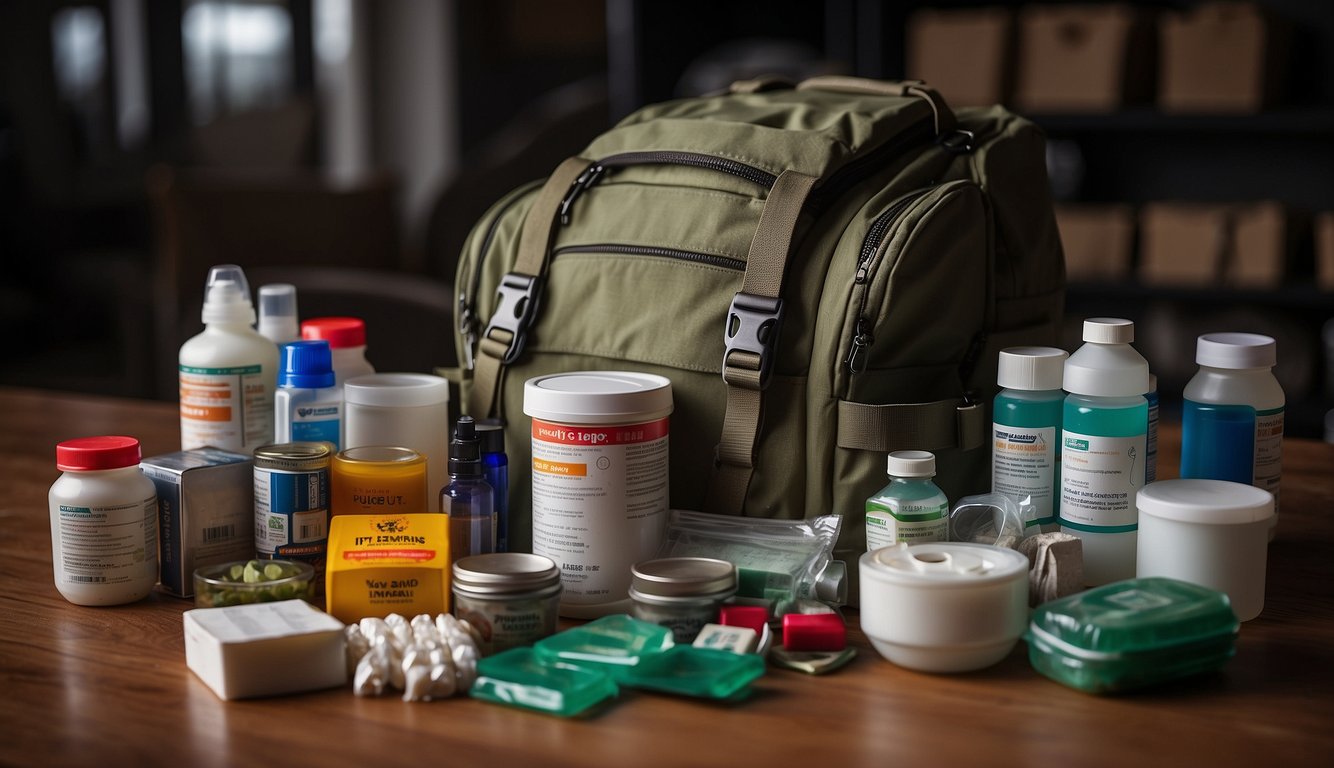
In a survival situation, ensuring you have the proper sustenance and nutrition is critical. Your bug out bag should contain a balanced selection of food and the necessary tools for its preparation, prioritizing both energy provision and easy usability.
Food Selection
Water: Your primary concern for survival is hydration. Always have water purification methods such as tablets or filters, alongside a minimum supply of water. Aim for at least one liter per day per person.
- Jerky: Offers a high-protein snack that’s lightweight and shelf-stable. Include a variety of jerky to prevent palate fatigue and provide essential nutrients.
- MREs (Meals Ready to Eat): These are complete meals that can sustain you in the absence of fresh food. MREs are calorie-dense and have a long shelf life, making them ideal for your kit.
- Food Bars: High-calorie food bars can provide quick energy and are compact.
Always check the expiration dates and rotate your food supplies to maintain their freshness and nutritional value.
Preparation Tools
In your bag, include lightweight and durable tools:
- Stainless Steel Cup: Can be used to boil water or cook liquid-based foods.
- Portable Stove: A compact and fuel-efficient stove will aid in warming meals or sterilizing water.
- Utensils: A spork or a small set of utensils is sufficient.
- Can Opener: If you’re carrying canned food, a can opener is a must.
Remember, each item adds weight, so balance your kit between essential needs and what you can realistically carry.
Personal Identification and Documentation
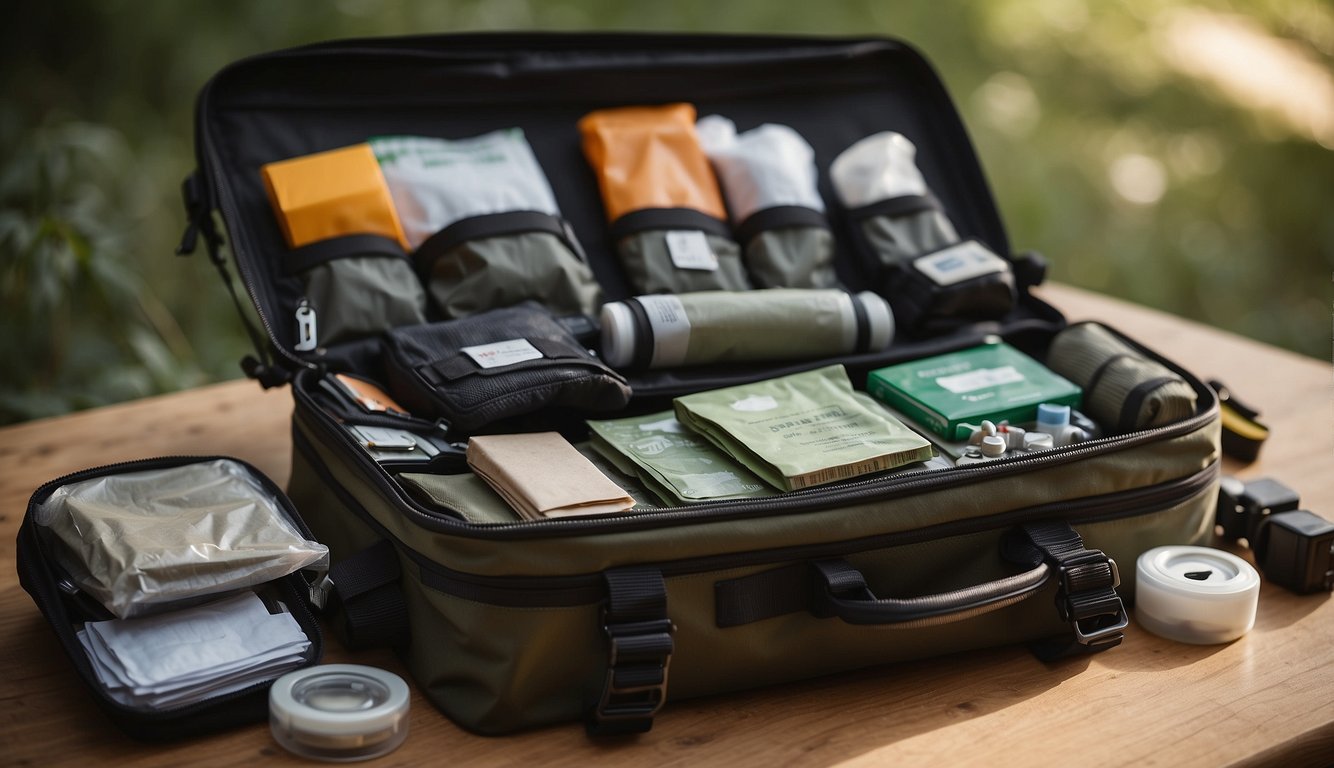
In a crisis, having your personal identification and documentation ready can make a significant difference in accessing services and maintaining your legal rights. Keep these items in a waterproof container within your bug out bag.
Important Documents
Your documents are your proof of identity and legal documentation. Therefore, they are absolutely essential. Here is a straightforward list of what to include:
- Personal Identification: Include copies of your driver’s license, passport, and social security card.
- Ownership Documents: Vehicle titles, property deeds, and insurance policies.
- Health Information: Medical history, prescriptions, health insurance cards.
- Emergency Contacts: A list of friends, family members, and important organizations.
Keep these documents in a sealed and waterproof pouch to prevent damage.
Emergency Cash and Resources
While cards are useful, cash is king in emergencies when electronic systems may fail.
- Cash: Keep a reasonable amount of small bills as vendors may not be able to make change.
- Gold or Silver: Small, tradable commodities can be beneficial in prolonged situations.
- Prepaid Phone Cards: These can be a lifeline if cell systems are overloaded or inaccessible.
Remember, a pen can also be invaluable to fill out forms, leave notes, or change information on your documents. Keep one clipped to your documents pouch for easy access.
Health Considerations and Special Needs
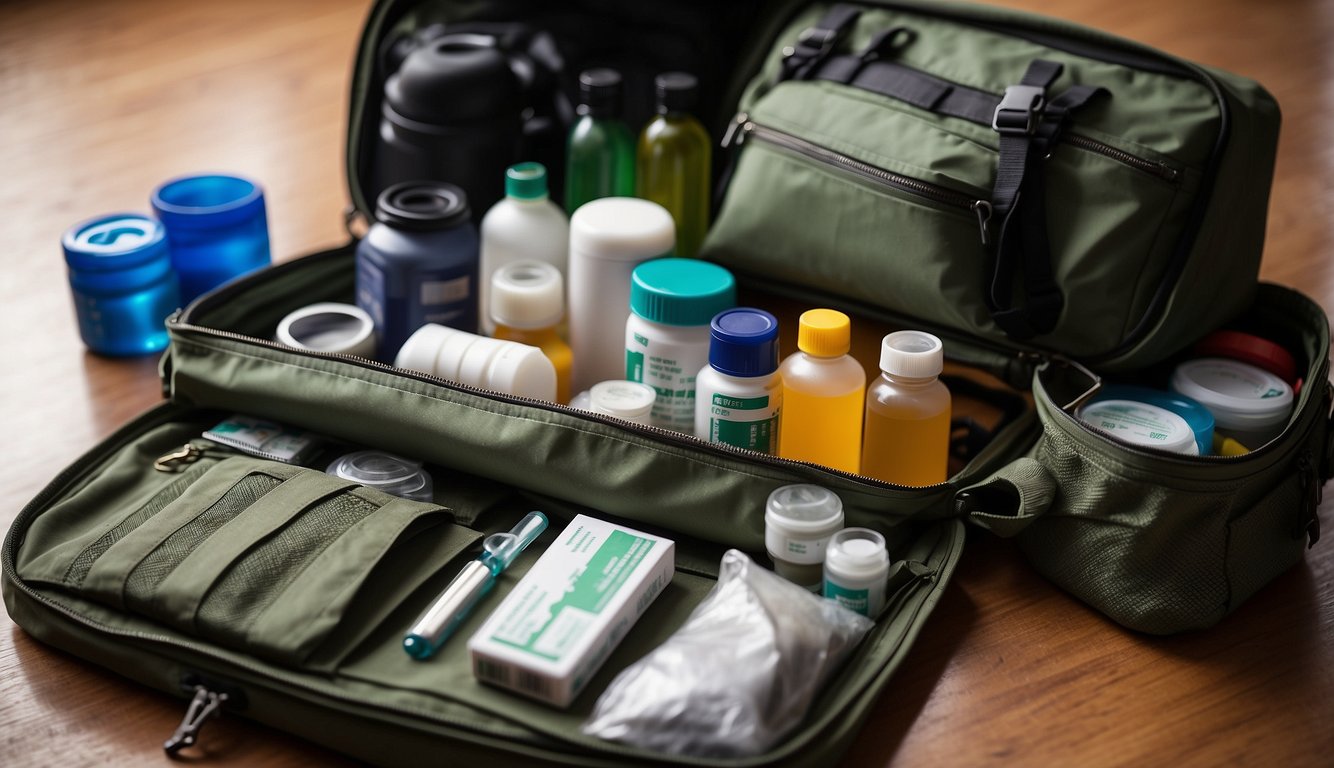
Preparing a Bug Out Bag (BOB) first aid kit requires careful consideration of health issues and special medical needs to ensure you are ready for any emergencies. For instance, managing chronic conditions and addressing allergies is vital for maintaining health during a stressful situation.
Chronic Conditions and Medications
If you have a chronic condition, such as diabetes or heart disease, it’s crucial to include a sufficient supply of your prescription medications. You should aim for a minimum of a one-week supply, but ideally as much as your BOB can sustain without adding excessive weight.
- Insulin & Syringes: For diabetics, store insulin vials or pens with a cooling pack to maintain their efficacy.
- Blood Pressure Medication: If you’re managing hypertension, your BOB should include your specific dose and a spare blood pressure monitor if possible.
Potassium iodide is a specific medication included in case of radiation exposure, important if you live near a nuclear plant or there’s a risk of a nuclear event.
Medication List: Always carry a list of your medications, dosages, and the medical conditions they are for. This will be essential if you need to inform healthcare providers or need to source additional supplies.
Allergies and Sensitivities
For those with allergies, pack antihistamines and any prescribed medications like epinephrine auto-injectors (EpiPens). Ensure they are up to date and you have clear instructions on their use if you’re incapacitated:
- Insect Allergies: Include treatments for insect bites or stings if you’re allergic.
- Food Sensitivities: Avoid including any food in your BOB that could trigger allergic reactions.
Keep medications in clearly marked containers, and consider waterproof packaging to protect against the elements. Also, wearing medical alert bracelets can swiftly inform others about your allergies in an emergency.
Situational Awareness and Safety
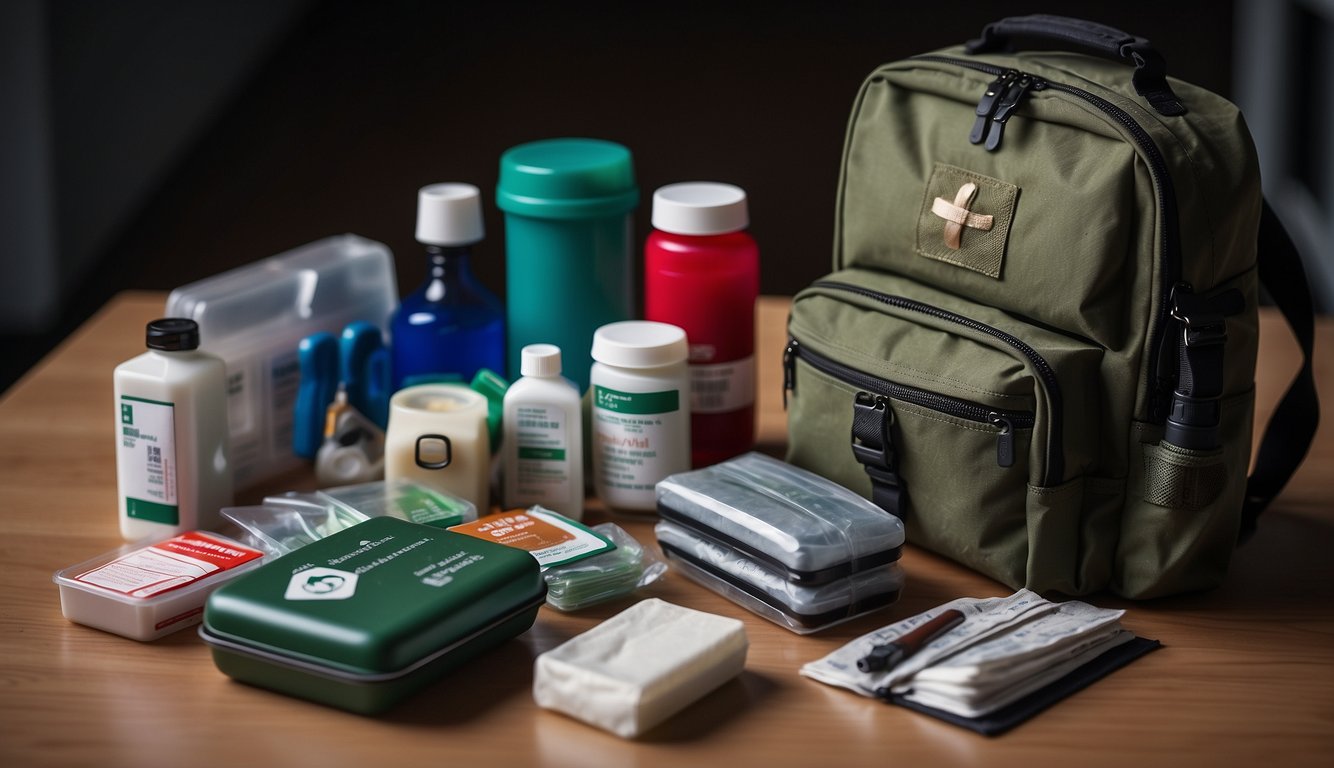
In the event of an emergency that requires you to evacuate, situational awareness is your first line of defense. Understanding your environment and knowing how to respond to various crises are crucial for your safety.
Adapting to the Environment
When dealing with variable climates, being able to adapt is key. Always check the weather forecast for your area and pack your first aid kit accordingly. For instance:
- Cold Climates: Include hand warmers and thermal blankets to prevent hypothermia.
- Hot Climates: Pack sunscreen and electrolytes to avoid heatstroke.
Consider the potential for fire in your area, and understand basic fire safety. If you’re in a fire-prone region, preserve a fire retardant and a small fire extinguisher in your bug out bag. Additionally, learn how to treat burns, as even minor ones can lead to infection if not handled properly.
Emergency Response Tactics
Your first aid kit should enable you to handle emergencies swiftly:
- Bleeding: Learn how to quickly apply a tourniquet or pressure dressing to control bleeding.
- Broken Bones: Stabilize fractures with splints to prevent further injury while you evacuate.
- Infection and Disease: Stock up on antiseptics and antibiotics, understanding that access to medical facilities might be limited for weeks post-SHTF.
- Mobility: Ensure you have supports, like crutches or slings, to maintain mobility in case of sprains or fractures.
Preppers often emphasize the need for a well-rounded first aid kit tailored to specific threats. Your safety hinges on preparedness and the ability to respond correctly under stress. Stay alert, stay informed, and stay safe.
Transportation and Relocation
When preparing your bug out bag and first aid kit, it’s crucial to consider how you’ll transport them to ensure you can evacuate quickly and efficiently. Your vehicle’s readiness and your strategy for movement are key.
Vehicle Readiness
Your Car: Check that your car, the primary means of relocation, is in good condition and ready to evacuate at a moment’s notice. Perform regular maintenance such as checking the oil level, tire pressure, and ensuring you have a full tank of gas. Keep an emergency tool kit including jumper cables, tire repair tools, and a spare tire within your vehicle.
Location-based Supplies: Adapt your vehicle’s supplies based on the planned evacuation route and the location’s specific needs. This might include maps, compass, and any necessary geographical tools that can help you navigate when conventional technology may fail.
Strategic Movement
Planning: Develop a clear evacuation plan that accounts for various scenarios and ensures mobility even in congested or compromised routes. Know multiple paths out of your location to avoid being trapped by unforeseen obstacles.
Evacuation Tools: Have a physical map and a compass in your bug out bag as backups to your car’s GPS system. In cases where driving is no longer feasible, ensure your bug out bag is portable enough to carry on foot or by any alternative means you may need to employ.
Remember, successful evacuation relies on both a sturdy vehicle and smart planning. Your preparation today is the foundation of your safety tomorrow.
Detailed Bug Out Bag First Aid Kit List
Your Bug Out Bag (BOB) is incomplete without an adequately prepared first aid kit. The goal is to be prepared for unforeseen medical emergencies, ensuring your survival kit is capable of addressing wounds, injuries, and basic health needs. Here’s a checklist to help you assemble your kit:
Wound Care:
- Sterile gauze pads
- Adhesive bandages in various sizes
- Medical tape
- Antibiotics ointment
- Tourniquet
- Alcohol prep pads
- Antiseptic wipes
Tools and Instruments:
- Medical-grade gloves
- Tweezers for splinter or tick removal
- Trauma shears
- Safety pins
- Cotton swabs
- Thermometer
Medication and Relief:
- Aspirin/Ibuprofen
- Antihistamine for allergic reactions
- Anti-diarrhea medication
- Laxatives
- Rehydration salts
- Potassium iodide tablets
Specialized Care:
- ACE bandage for sprains
- Burn gel or cream
- Suture kit or wound closure strips
- Blister treatment (Moleskin or similar)
- Eye wash solution
Survival Essentials:
- Emergency blanket to prevent hypothermia
- Multitool with scissors and tweezers
- Hand sanitizer for hygiene
- Sunscreen and lip balm
- Insect repellent
Hydration and Nutrition:
- Water purification tablets
- Compact water filter
Remember, a first aid kit must be lightweight, as it’s an essential part of your BOB which may need to be carried over long distances. Rehearse the use of these items to ensure you can provide swift and effective care in a crisis. Regularly check the contents for expiry dates, and replenish supplies as needed to maintain a complete and reliable first aid kit in your Bug Out Bag.
Frequently Asked Questions
When preparing your bug out bag, incorporating a well-stocked first aid kit is vital to ensure that you can handle medical emergencies during an evacuation.
What essential items should you include in a go bag for medical emergencies?
Your bug out bag’s first aid kit should include items to handle severe and minor injuries, such as different types of bandages, antiseptics, sterile gloves, pain relievers, and essential medications for immediate care of wounds or ailments.
How can you tailor a bug out bag first aid kit list to different survival scenarios?
Tailoring your kit means considering the environments you may traverse and potential injuries. For instance, if you’re in snake territory, include a snake bite kit; in wooded areas, tick removal tools could be essential.
What are the top 10 first aid supplies for handling injuries during an emergency evacuation?
The top 10 supplies are adhesive bandages, gauze pads, medical tape, a tourniquet, antiseptic wipes, nitrile gloves, a CPR mask, emergency blankets, pain relievers, and a multitool with scissors.
How does the first aid kit in a tactical bug out bag differ from a standard emergency kit?
A tactical first aid kit typically includes advanced supplies like chest seals, a tourniquet, combat gauze, and it’s typically designed for more severe injuries, often catering to those with advanced first aid knowledge.
What are the benefits of having a premade first aid kit in your bug out bag?
A premade kit saves time, ensures you have a comprehensive range of supplies that meets general emergency needs, and usually comes in durable, organized packaging for quick and easy use in high-stress situations.
What factors should you consider when assembling a first aid kit for your family’s bug out bag?
Consider the specific health needs of your family members, the length of time you’ll be away from medical facilities, the challenges of the environment you may find yourself in, and the weight and compactness of the kit in your bug out bag.

Leave a Reply